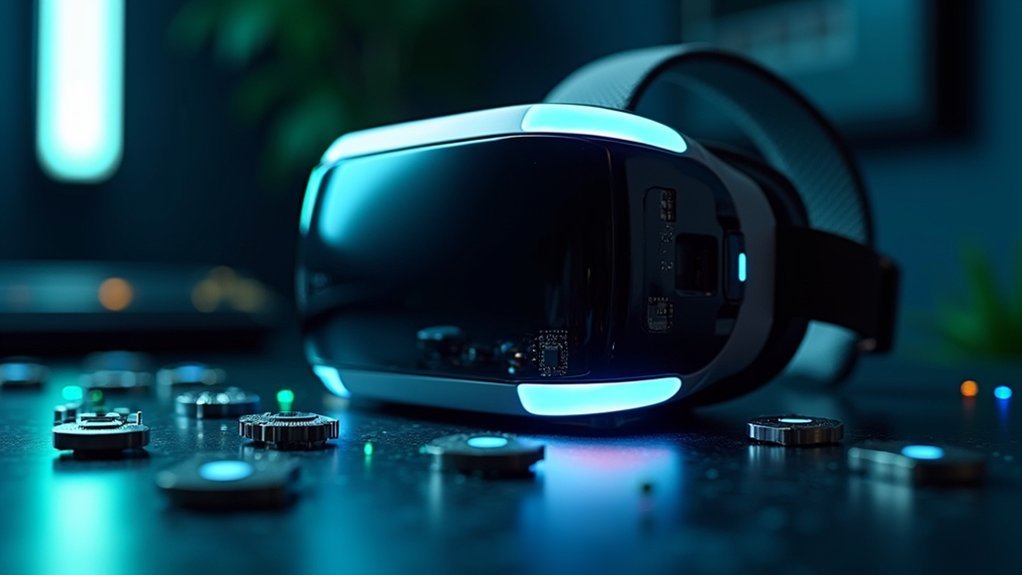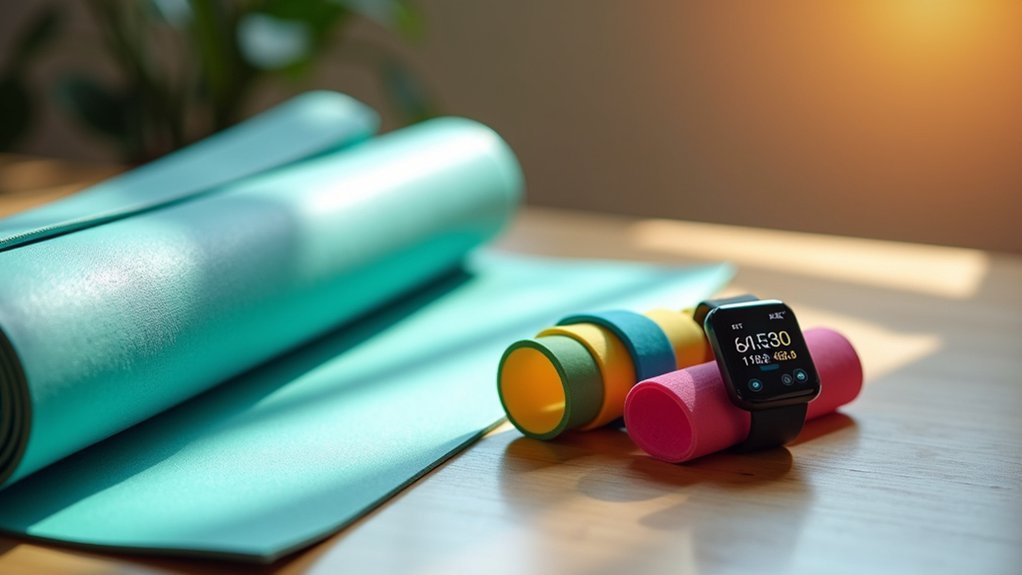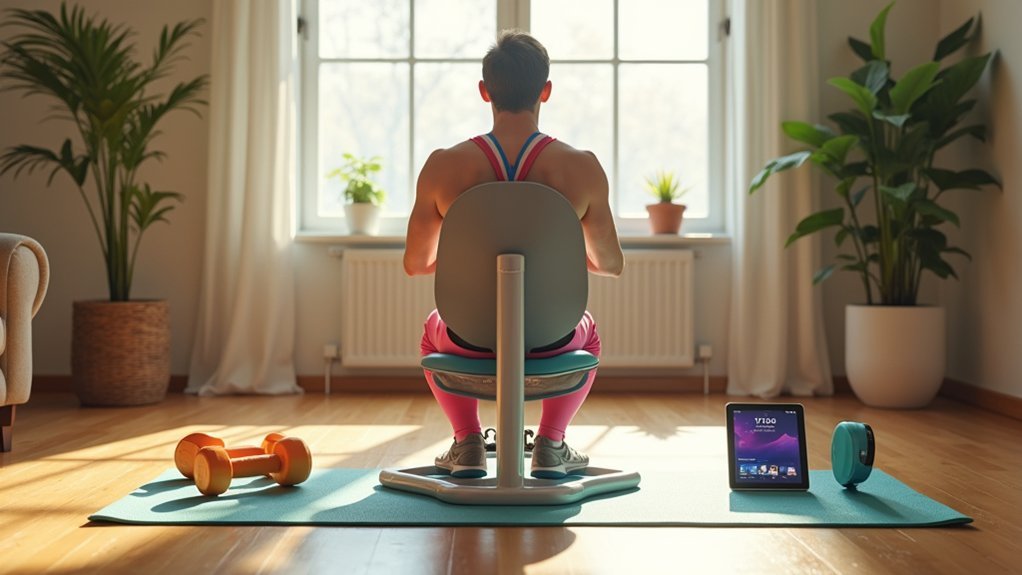VR tracking precision depends on your hardware sensors (accelerometers, gyroscopes, magnetometers), environmental conditions, and tracking technology. Factors like lighting (avoid direct sunlight and low light), occlusion (objects blocking sensors), movement speed (faster movements reduce accuracy), and algorithm quality all affect performance. Your body positioning and grip consistency matter too. Inside-out systems offer portability while outside-in systems provide better precision. Understanding these elements will help you optimize your VR experience beyond basic setup.
Hardware Sensors: The Foundation of Tracking Precision
When you step into a virtual reality experience, the precision of your movements depends entirely on the hardware sensors working behind the scenes. Accelerometers track your linear movements along three axes, while gyroscopes capture your rotational movements with 360-degree tracking capability.
Magnetometers add another dimension by determining your orientation relative to magnetic fields.
Magnetometers silently interpret Earth’s invisible forces, ensuring your virtual presence stays perfectly oriented in digital space.
For ultimate precision, many VR systems use Inertial Measurement Units (IMUs) that combine these sensors into a single package. This integration enables sensor fusion, where software algorithms blend data from multiple sources to enhance accuracy and reduce latency. The combination creates a six degrees of freedom tracking system that provides the most realistic virtual experience.
The miniaturization of these components has allowed for more compact, comfortable devices without sacrificing performance.
Remember that proper calibration of these sensors is vital for maintaining accurate tracking during your VR sessions.
Environmental Factors Affecting VR Tracking Performance
Your VR tracking performance is considerably influenced by the environment in which you’re using it.
Light conditions can make or break optical tracking systems, with both too bright and too dim lighting causing sensor failures.
Occlusion problems arise when objects block the line of sight between tracking sensors and headsets, creating jumps or freezes in your virtual experience. Outside-in tracking systems are generally less susceptible to occlusion issues compared to inside-out methods.
Environmental Factors Affecting VR Tracking Performance
Environmental factors play an essential role in determining the accuracy and reliability of VR motion tracking systems. Your tracking performance can greatly deteriorate due to interference from crowded spaces, moving objects, or poorly configured room layouts.
When setting up your VR system, consider both the physical space and potential movement within it.
- High crowd density can increase tracking errors by obstructing sensor visibility
- Moving objects can introduce errors up to 12.584 mm
- Room size and layout affect sensor performance, with larger rooms often requiring additional sensors
- Inside-out tracking works better in variable environments like living rooms
- Outside-in tracking systems need stable conditions and strategic sensor placement in corners or walls
Regular calibration helps maintain accuracy in dynamic environments where furniture might be rearranged. Metallic objects can cause significant distortion in electromagnetic tracking systems, particularly affecting systems that rely on measuring magnetic field strength.
Light Conditions Matter
Light conditions represent another major factor that can make or break your VR tracking performance. VR systems rely on infrared cameras that function best in controlled lighting environments. Poor lighting introduces jitter and precision loss, while stable brightness maintains accuracy. The use of ultra-black coatings on internal components significantly improves IR sensor accuracy by reducing unwanted scattering.
| Lighting Condition | Effect on Tracking | Solution |
|---|---|---|
| Low light/darkness | Significant degradation | Add consistent room lighting |
| Bright, stable light | ideal performance | Maintain even illumination |
| Dynamic/fluctuating light | Minimal impact if gradual | Avoid sudden light changes |
| Direct sunlight | Tracking failure | Use indoors with controlled light |
Internal reflections within headsets can also corrupt sensor data. Manufacturers combat this using specialized coatings like Magic Black™ on optical surfaces to reduce stray IR reflections. When setting up your VR space, prioritize consistent, bright illumination while avoiding direct sunlight.
Occlusion Creates Errors
Occlusion represents one of the most challenging hurdles in VR tracking accuracy, occurring when physical objects block the line of sight between tracking sensors and your headset or controllers. This interference disrupts the system’s ability to properly track your movements, resulting in jittery or delayed virtual responses.
- Strategic sensor placement can greatly reduce occlusion problems.
- Dynamic environments create more frequent tracking errors than static setups.
- Your viewing angle and position affect how severely occlusion impacts experience.
- Base station configuration plays an essential role in minimizing blind spots.
- Advanced algorithms help predict movement during momentary occlusion events.
Both static (permanent) obstacles like furniture and dynamic (temporary) obstructions like your own body contribute to tracking errors.
Even the most advanced systems like SteamVR 2.0 struggle when multiple sensors lose sight of tracking points simultaneously.
Research shows that using four base stations instead of two significantly improves tracking robustness during occlusion events.
How Movement Speed and Range Impact Accuracy
When you’re moving in virtual reality, the speed of your movements directly affects tracking precision. At high speeds (900 mm/s), you’ll experience tracking loss up to 34%, while slowing down to under 135 mm/s reduces this to less than 0.5%.
Your HMD typically maintains better accuracy than controllers or trackers, which struggle most at higher velocities. Recent studies showed that Oculus Quest 2 outperforms SteamVR tracking systems in both accuracy and precision.
Range also plays an essential role in tracking accuracy. As you move farther from sensors, occlusion becomes more likely, degrading precision. Proper sensor placement can mitigate this issue, but you’ll still face limitations based on your device’s field of view and spatial coverage capabilities.
The predictability of your movements matters too—unpredictable motions combined with speeds above system thresholds will greatly reduce tracking accuracy, especially with latencies exceeding 130 ms.
The Role of Algorithm Processing in Tracking Fidelity
Algorithm processing forms the backbone of VR motion tracking, turning raw sensor data into the seamless movement you experience in virtual environments. The algorithms you’re using greatly impact how accurately your movements translate into virtual worlds.
The algorithms behind VR tracking transform raw data into fluid virtual motion, directly determining how naturally you move in digital spaces.
- Kalman filters minimize errors through probabilistic estimation, essential for real-time tracking.
- Neural networks (especially RNNs) excel at processing complex time-series motion data.
- Data integration methods combine multiple sensor inputs for enhanced accuracy.
- Noise reduction algorithms filter out unwanted signals that would otherwise create jitter.
- Occlusion handling techniques maintain tracking when markers or objects become hidden.
The quality of algorithm processing directly affects latency, precision, and the ability to track in complex environments. Recent validation studies have demonstrated that VR tracking systems can achieve accuracy within 0.7 ± 0.3 cm translationally when compared to gold-standard camera-based systems.
Well-calibrated systems with sophisticated algorithms can greatly reduce the gap between your physical movements and their virtual representation.
Body Positioning and User-Related Precision Factors
How you position your body greatly impacts the precision of VR motion tracking systems. Occlusion, where body parts block sensors, forces systems to rely on less accurate estimation algorithms. Your movements near tracking boundaries or performing rapid actions can cause jitter or data loss. The quality of tracking also depends significantly on whether your system uses 3DoF or 6DoF tracking capabilities, with the latter providing much more comprehensive spatial awareness.
| Factor | Impact on Tracking |
|---|---|
| Posture | Affects IK algorithm accuracy and joint angle calculations |
| Clothing | Reflective/absorbent materials interfere with optical tracking |
| Movement Speed | High acceleration challenges real-time positional updates |
| Body Dimensions | Influences calibration fit and pose estimation accuracy |
Personal factors like grip consistency, fatigue, and your unique movement patterns also affect tracking fidelity. For best results, maintain visibility to sensors, use personalized calibration, and avoid extreme posture changes that might confuse the tracking system.
Comparing Tracking Technologies Across Leading VR Systems
Two fundamental approaches divide the VR tracking landscape: inside-out and outside-in technologies, each with distinct advantages for different use cases.
When comparing systems across major headsets, you’ll notice significant differences in tracking precision, environmental requirements, and use cases.
- Meta Quest and Windows Mixed Reality employ inside-out tracking using SLAM algorithms, offering portability with no external hardware.
- HTC Vive and Valve Index use lighthouse base stations (outside-in), delivering higher precision with static errors of only 3mm.
- PlayStation VR relies on an external camera system for tracking, falling between the two approaches.
- Inside-out systems struggle in low-light environments but require minimal setup.
- Outside-in systems like Vive experience fewer tracking errors at lower velocities (<135 mm/s) but can suffer from occlusion issues.
Self-tracking systems like the VIVE Ultimate Tracker combine both Computer Vision and IMU technologies to eliminate drift issues while maintaining freedom of movement without base stations.
Real-World Testing vs. Laboratory Performance Metrics
While VR manufacturers tout impressive tracking precision in their marketing materials, significant discrepancies exist between laboratory performance metrics and real-world usage scenarios. These gaps occur because lab environments use ideal calibration volumes and controlled conditions that don’t reflect your actual play space. Recent studies using collaborative robots to simulate head movements have demonstrated these differences with high precision.
| Metric | Lab Setting | Real-World Setting | Impact |
|---|---|---|---|
| Positional Error | 10.5-12mm max | Often exceeds lab values | Imprecise hand interactions |
| Tracking Volume | 0.3m³+ ideal space | Smaller, constrained areas | Reduced tracking stability |
| Lighting Conditions | Uniform, controlled | Variable, reflective | Tracking inconsistency |
| Occlusion Handling | Minimized | Frequent (furniture, limbs) | Tracking dropouts |
You’ll experience higher latency in real settings due to processor load variations, wireless transmission, and environmental interference—factors that controlled testing environments simply don’t capture.
Frequently Asked Questions
How Does Magnetometer Calibration Affect Tracking Stability Over Time?
Proper magnetometer calibration minimizes yaw drift and orientation errors by correcting hard-iron and soft-iron distortions. You’ll maintain tracking stability over time through frequent recalibration, which compensates for environmental magnetic field changes during extended use.
Can VR Tracking Precision Be Affected by Nearby Wireless Networks?
Yes, your VR tracking precision can greatly affected by nearby Wi-Fi networks operating on the 2.4 GHz band, as they create interference that disrupts data transmission between your VR trackers and dongles.
Do Software Updates Typically Improve or Disrupt Tracking Accuracy?
Software updates typically improve your tracking accuracy by enhancing prediction algorithms, reducing jitter, and implementing better machine learning logic. While occasional disruptions can occur initially, they’re usually resolved quickly in subsequent patches.
How Does User Height Influence Tracking Precision Across Different Systems?
Your height affects tracking precision differently across VR systems. You’ll experience better accuracy with inside-out tracking like Oculus Quest 2, while SteamVR and fixed sensors may struggle with your height if you’re unusually tall.
Can Tracking Precision Be Maintained With Multiple HMDS in Proximity?
Yes, you can maintain tracking precision with multiple HMDs nearby through active LED marker identification, hybrid optical-inertial systems, and strategic camera placement that prevents occlusion and distinguishes devices even in crowded VR environments.
In Summary
You’ll find that VR tracking precision depends on a combination of hardware quality, environmental conditions, and software algorithms working together. Your movement patterns and body positioning greatly influence accuracy, while different tracking technologies offer varying strengths. When evaluating a system’s performance, remember that real-world usage often reveals limitations that controlled testing environments might miss.





Leave a Reply